Panasonic 14-42mm f/3.5-5.6 Micro Four Thirds Zoom Lens Review
Panasonic 14-42mm f/3.5-5.6 Lens Performance
At 14mm sharpness in the centre of the frame approaches outstanding levels at maximum aperture, although the clarity towards the edges falls short of good levels. Stopping the lens down a little improves quality across the frame with peak quality across the frame being achieved at f/5.6, where the sharpness in the centre is outstanding, and excellent towards the edges.Zooming to 25mm improves the sharpness towards the edges at maximum aperture to good levels and the excellent centre sharpness is maintained. Peak quality across the frame is achieved at f/8 for this focal length where sharpness across the frame is excellent.
Overall clarity drops off a little at 42mm, especially at maximum aperture, although the sharpness is still good. Stopping the lens dow to f/8 results in excellent sharpness across the frame for this focal length.
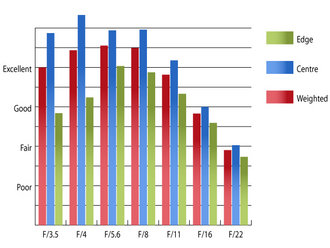 Resolution at 14mm | 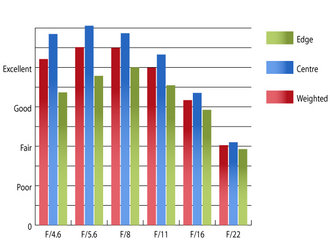 Resolution at 25mm | |
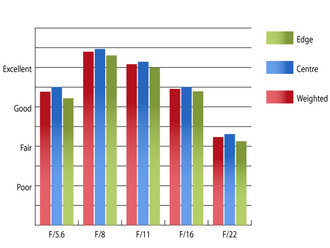 Resolution at 42mm | How to read our chartsThe blue column represents readings from the centre of the picture frame at the various apertures and the green is from the edges. Averaging them out gives the red weighted column.The scale on the left side is an indication of actual image resolution. The taller the column, the better the lens performance. Simple. For this review, the lens was tested on a Panasonic Lumix G3 using Imatest. |
Levels of chromatic aberrations are kept within acceptable levels throughout the zoom range. At their worst they exceed half a pixel width at 42mm and f/11. Even this level will be low enough to pose few issues, even in large prints and harsh crops from the edges of the frame.
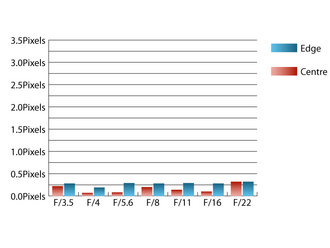 Chromatic aberration at 14mm | 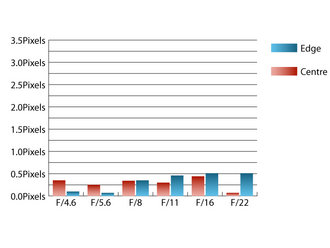 Chromatic aberration at 25mm | |
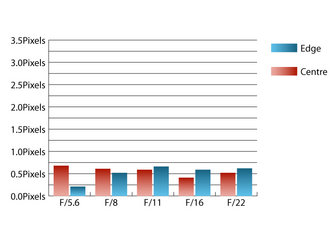 Chromatic aberration at 42mm | How to read our chartsChromatic aberration is the lens' inability to focus on the sensor or film all colours of visible light at the same point. Severe chromatic aberration gives a noticeable fringing or a halo effect around sharp edges within the picture. It can be cured in software.Apochromatic lenses have special lens elements (aspheric, extra-low dispersion etc) to minimize the problem, hence they usually cost more. For this review, the lens was tested on a Panasonic Lumix G3 using Imatest. |
As falloff and distortion are corrected by the camera's image processing engine when shooting JPEGs, falloff and distortion will only be easily visible when shooting in RAW format.
Falloff of illumination towards the corners of the frame is reasonably well controlled. At 14mm the corners are 1.53 stops darker than the image centre and visually uniform illumination is achieved at f/5.6. At 42mm, the corners are only 0.9 stops darker than the image centre and visually uniform illumination is achieved at f/8.
Distortion levels are typical for a 3x zoom lens, with a moderate level of 1.31% barrel distortion being present at 14mm and 1.02% pincushion distortion at 42mm. Throughout the zoom range, the distortion pattern is uniform across the frame, which should make any curvature easy to correct in software afterwards.
Even when shooting directly into the light, this lens is quite resistant to flare, with the occasional green / blue spot appearing in images taken under extreme conditions. Contrast holds up well, even when shooting directly into the light. A petal shaped hood also helps to sheild the front element from extraneous light.
Add your message
Login required
Please login here or if you've not registered, you can register here. Registering is safe, quick and free.
Please login here or if you've not registered, you can register here. Registering is safe, quick and free.
photodo Stats
1102 lenses
428 MTF tests
74 in-depth photodo reviews
100+ users join each day
Help the lens community by reviewing or rating a lens today via our lens search
428 MTF tests
74 in-depth photodo reviews
100+ users join each day
Help the lens community by reviewing or rating a lens today via our lens search
Latest Lens Reviews
- Chinon 28mm f/2.8 Vintage Lens Review
- Canon EF 70-200mm f/4L IS II USM Lens Review
- Samyang AF 85mm f/1.4 EF Review
- Sigma 70mm f/2.8 DG Macro Art Review
- Samyang AF 24mm f/2.8 FE Review
- Meike 50mm f/1.7 Review
- Tamron 70-210mm f/4 Di VC USD Review
- Lensbaby Burnside 35mm f/2.8 Review
- Asahi Super Takumar 50mm f/1.4 Review
- Asahi Super-Multi-Coated Takumar 135mm f/3.5 Review
